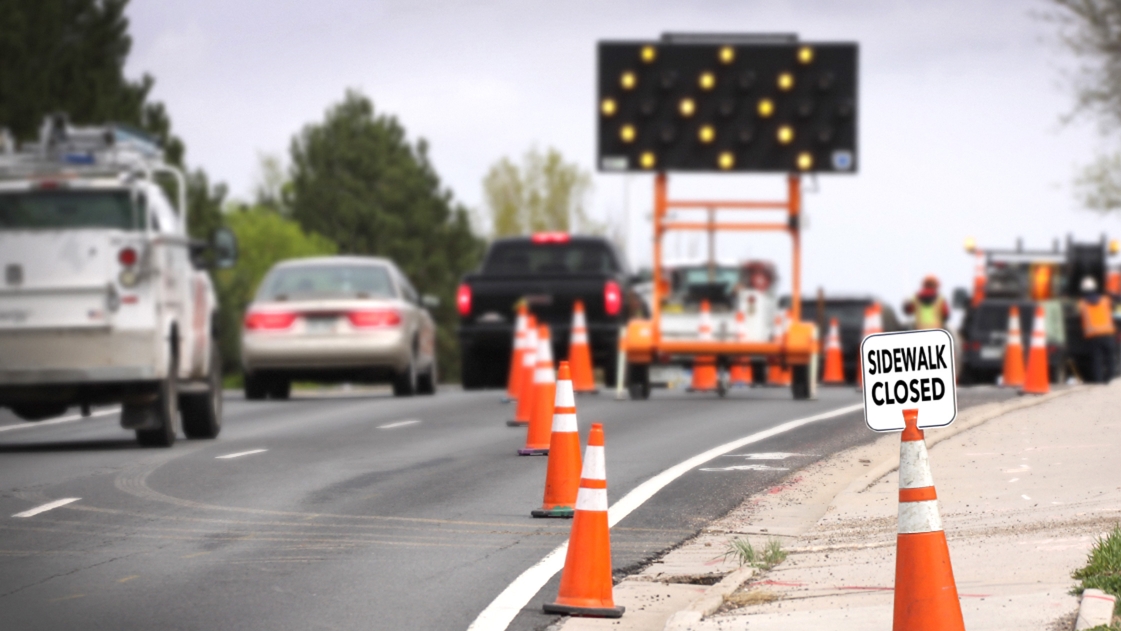Four Ways to Keep Drivers Safe during Road Construction

What’s a typical driver’s worst nightmare? Rush hour. Even worse? Rush hour in a road construction zone.
Currently, there are 4.12 million miles of road in the United States, according to the Federal Highway Administration: 2.94 million miles are located in rural areas, with the remaining 1.18 million miles located in urban areas. In 2013, the latest data available, the FHWA found that 161,971 miles, or 16.1 percent, were in poor or mediocre condition and needed repaving or even more substantive repairs. My point? That’s a lot of road construction.
Roads are a lot like a house roof. You can do small repairs that will maintain its functionality but eventually you’ll need a whole new roof. As transportation engineers, we often work with clients during road construction projects. We try to “patch” repair as often as possible, but it’s also necessary to do complete overhauls from time to time.
The U.S. Department of Transportation has compiled some facts and statistics related to work zone statistics. In 2015, for example, there were an estimated 96,626 crashes in work zones.
Our number one goal during road construction: keeping the public safe and preventing traffic accidents. There are four ways to do this:
1. Signage
Construction warning devices such as warning signs, flashing beacons, pavement markings, portable changeable message signs, dynamic message signs and arrow boards are usually sufficient to alert and guide drivers safely around or through work zones. Occasionally, however, there are exceptional circumstances where drivers become inattentive and, therefore, fail to respond to hazardous situations quickly enough or may entirely misjudge conditions.
2. Rumble strips
Traffic can get backed up during road construction. This can cause accidents as drivers may need to break quickly or unexpectedly. If this is a problem we foresee, one solution is to use temporary rumble strips, which are raised pavement markings placed perpendicular to the path of vehicles and across the full width of a roadway. These alert drivers that it’s time to slow down and pay attention.
3. Sensors to predict congestion
Additionally, signs or small trailers with sensors placed along the highways can detect slow-downs and provide advanced messages further back from the construction zone to warn motorists of the slowed traffic ahead. These sensors can also provide data to our traffic engineers that will allow them to improve placement of additional signs. While it’s an additional cost, this predictive analysis can prevent disasters.
4. Explore lane closure options
Based on the level of repair needed, it may be possible to keep the roads open during construction. If multiple lane closures that would restrict traffic are necessary, we try to weigh the pros and cons close the highway completely in order to complete the project as quickly as possible versus keeping it open and working at night and weekends when traffic is its lightest.
Of course, another option is just to restrict the lanes and work during weekdays, and communicate broadly to help the public understand the reasons behind the construction and how it will impact their commute.
- If you’re a transportation manager and trying to determine the pros and cons of closing a road during construction, consider these questions:
- Does the road provide exclusive access to locations critical to the community such as schools, hospitals or businesses?
- Is the road in an area where night and weekend work will be excessively disturbing to residents?
- Will the public prefer to deal with a greater disruption for a lesser amount of time, or a much longer (more than twice as long) construction period?
- Are there easy detour routes in good condition to take the increased traffic?
- Will construction impact roadways during voting periods?
When completing road construction, we all want to achieve our goals of safety and quality while staying on time and in budget. Our team can talk you through all the considerations and determine the best solutions for you.

